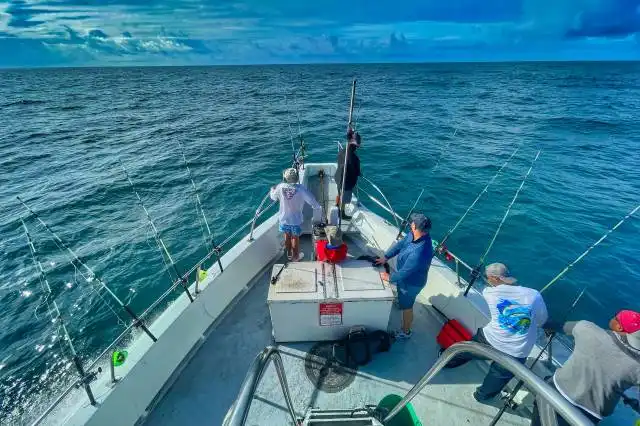Start a Glass Bottom Boat Tour Business
Venturing into the Deep: Swim with the Sea Life Without Getting Wet!
| Updated


GLASS BOTTOM BOAT TOUR BUSINESS
Embark on a liquid adventure with a glass bottom boat tour business! This is a venture that offers guided tours through bodies of water while giving passengers a clear view of what lies beneath, thanks to transparent flooring. It's like taking individuals on a swim with the sea life, no bathing suits needed! Perfect for coastal and lake regions, your business will blend the thrill of marine exploration with the comfort and safety of a boat tour.
Jump to Business Plan
RELATED BUSINESS IDEAS
Browse ALL Hospitality & Leisure Ventures Business Ideas
Discover Your Perfect Domain
Unlock the door to your online success with our hand-picked selection of premium domain names. Whether you're starting a new venture or rebranding an existing one, the right domain can set the tone for your digital presence. Browse through our curated list, each with its unique potential to enhance your brand's visibility and credibility.
GLASS BOTTOM BOAT TOUR MINI BUSINESS PLAN
This a quick reality check to help you identify the strengths and weaknesses of your business concept before you dive in.
Expected Percent Margin:
- Gross Margin: 45-55%
- Net Profit Margin: 15-25%
Earnings Expectations:
- Daily Earnings: $300 - $700
- Weekly Earnings: $2,100 - $4,900
- Monthly Earnings: $8,400 - $19,600
- Annual Earnings: $100,800 - $235,200
Actions to Hit Those Numbers:
Equipment and Maintenance:
- Initial Investment: At least $50,000-$75,000 for a high-quality glass-bottom boat and docking facilities.
- Routine maintenance and inspections: Allocate around 5-10% of your monthly earnings to keep your boat in top condition.
Marketing and Customer Acquisition:
- Social Media: Post thrilling underwater moments captured from your tours 3-4 times a week on Instagram and Facebook.
- Partnerships: Network with local hotels and travel agencies for referrals.
Tour Bookings and Customer Experience:
- Staffing: Hire experienced boat drivers and possibly tour guides who can share interesting facts about the area and underwater wildlife.
- Customer Experience: Personalize the tour as much as possible (e.g., theme days, special group tours).
Cost Control:
- Insurance: Ensure that you have comprehensive insurance to cover any damage or accident costs. Expect to allocate about 3-5% of monthly earnings to this.
- Fuel and Utilities: Factor in recurring fuel costs and bills into your monthly budget.
Business Operations:
- Tour frequency: Conduct 3-4 tours per day in peak seasons, considering the capacity of your boat and the duration of each tour.
- Ticket Pricing: Charge competitive ticket prices by considering the local market and the unique experience your tour offers (average is around $20-$40 per ticket).
These are generalized estimations and can vary depending on location, the season, economic conditions, and individual business strategies. Always consult with a financial advisor for personalised advice.
NOT WHAT YOU HAD IN MIND? Here are more ideas



Browse ALL Hospitality & Leisure Ventures Business Ideas
Grab Your Business Website Name
Before you get caught up in the whirlwind of setting up your business, invest in a domain name. It's a small but significant step that lays the foundation for your brand and makes it easier for customers to find and trust you. Just like you wouldn't build a house without securing the land first, don't build a business without securing your domain name.
"Why? Can't that wait?" Here's why it shouldn't
Step 1: Determine if a Glass Bottom Boat Tour Business is Right for You
Breakdown of Startup Expenses
When considering starting a glass bottom boat tour business, it is important to understand the startup costs associated with the endeavor. These costs include the cost of the boat, any necessary permits, insurance, and marketing. Additionally, the cost of any necessary equipment, such as life jackets and safety equipment, should be taken into account. It is also important to consider the cost of any necessary staff, such as tour guides, and the cost of any necessary training. Finally, the cost of any necessary advertising should be taken into account.
Breakdown of Ongoing Expenses
In addition to the startup costs, it is important to consider the ongoing expenses associated with running a glass bottom boat tour business. These expenses include the cost of fuel, maintenance, and repairs. Additionally, the cost of any necessary staff, such as tour guides, should be taken into account. It is also important to consider the cost of any necessary training, as well as the cost of any necessary advertising. Finally, the cost of any necessary permits and insurance should be taken into account.
Examples of Ways to Make Money
When starting a glass bottom boat tour business, it is important to consider the various ways to make money. For example, the business could charge customers a fee for each tour, or could offer packages that include multiple tours. Additionally, the business could offer merchandise, such as t-shirts or hats, for sale. Furthermore, the business could offer additional services, such as food and beverage services, for an additional fee. Finally, the business could offer discounts for large groups or for repeat customers.
Step 2: Naming the Business
Brainstorm potential names When brainstorming potential names for a glass bottom boat tour business, it is important to consider names that reflect the unique experience of the business. Think of words that evoke the feeling of being on the water, such as “wave”, “ocean”, “tide”, “water”, “sea”, “coast”, “shore”, “voyage”, “cruise”, and “tour”. Additionally, consider words that evoke the feeling of looking through a glass bottom boat, such as “discovery”, “explore”, “reveal”, “uncover”, “observe”, and “view”. Combining these words can create a name that is both unique and memorable.
Check the availability of the name Once potential names have been brainstormed, the next step is to check the availability of the name. This can be done by searching the internet to see if the name has already been taken. Additionally, it is important to check with the local government to see if the name is available to be registered as a business.
Consider the implications of the name When choosing a name, it is important to consider the implications of the name. For example, the name should not be offensive or inappropriate in any way. Additionally, the name should not be too long or complicated, as it should be easy to remember and pronounce.
Make sure the name is unique When choosing a name, it is important to make sure the name is unique. This can be done by searching the internet to see if the name has already been taken. Additionally, it is important to check with the local government to see if the name is available to be registered as a business. It is also important to consider the implications of the name and make sure it is not too similar to any other business names in the area.
Step 3: Obtain Necessary Licenses and Permits
Research Local and State Regulations
Before starting a glass bottom boat tour business, it is important to research the local and state regulations that may apply to the business. Depending on the location, the business may need to obtain a variety of licenses and permits, such as a business license, a boat operator’s license, and a tour guide license. It is important to research the regulations for the specific area to ensure that all necessary licenses and permits are obtained.
Obtain Necessary Licenses and Permits
Once the necessary regulations have been researched, the business must obtain the necessary licenses and permits. This process can vary depending on the location, but typically involves submitting an application and paying the associated fees. It is important to ensure that all licenses and permits are obtained before beginning operations, as failure to do so could result in fines or other penalties. Additionally, the business should ensure that all licenses and permits are kept up to date and renewed as needed.
Step 4: Secure a Business Location
Once you have determined that starting a glass bottom boat tour business is the right endeavor for you and you have named your business, the next step is to secure a business location. When selecting a location for your business, there are several important factors to consider. First, you must decide if you want to operate your business from a physical location or if you will operate it from a virtual location. If you decide to operate from a physical location, you must consider the size of the space, the cost of the rent, and the proximity to your target customer base. Additionally, you must make sure that the space is zoned for the type of business you plan to operate.
Obtaining Necessary Permits
Once you have identified a suitable location for your business, you must obtain the necessary permits and licenses. Depending on your location, you may need to obtain a business license, a zoning permit, and a health permit. Additionally, you may need to obtain a permit to operate a boat tour business. You should contact your local government office to determine which permits and licenses you need to obtain. Additionally, you may need to obtain a liability insurance policy to protect your business from potential lawsuits.
Leasing or Purchasing a Boat
The next step is to lease or purchase a boat for your business. When selecting a boat, you must consider the size, the cost, and the features. You should also consider the safety features of the boat, such as life jackets and fire extinguishers. Additionally, you should consider the type of engine the boat has, as this will affect the speed and maneuverability of the boat. Finally, you should consider the type of glass bottom the boat has, as this will affect the visibility of the underwater environment.
Step 5: Purchase Equipment
When starting a glass bottom boat tour business, it is important to purchase the necessary equipment. This includes the boat itself, life jackets, and any other safety equipment that may be required. Additionally, it is important to purchase any navigational and communication equipment that may be necessary, such as a GPS system, a VHF radio, and a depth sounder. Depending on the size of the boat, it may also be necessary to purchase a trailer for transporting the boat. Furthermore, it may be necessary to purchase a generator and other electrical equipment to power the boat. Finally, it may be beneficial to purchase any additional equipment that could make the tour more enjoyable, such as a stereo system or a cooler.
Cost of Equipment
When starting a glass bottom boat tour business, it is important to consider the cost of the necessary equipment. The cost of the boat itself will vary depending on the size and type of boat, as well as any additional features that may be included. Additionally, the cost of the safety and navigational equipment will vary depending on the type and quality of the equipment. Furthermore, the cost of the trailer and any additional equipment will also need to be taken into consideration. Finally, it is important to factor in the cost of any necessary repairs and maintenance that may be needed for the boat and its equipment.
Step 6: Develop a Business Plan
The business plan should include a detailed outline of the business, including the goals and objectives, the target market, the marketing strategy, the financial projections, and the operational plan. It should also include a description of the services offered, a list of the equipment and supplies needed, and a timeline for launching the business.
Financial Projections
Financial projections are an important part of the business plan. They should include an estimate of startup costs, such as the cost of purchasing the boat, any necessary permits and licenses, and any other equipment or supplies needed. They should also include estimates of ongoing expenses, such as fuel, maintenance, and labor costs. Finally, they should include estimates of potential revenue, such as ticket sales, advertising, and other sources of income.
Operational Plan
The operational plan should include a detailed description of the services offered, such as the types of tours available, the duration of the tours, and the cost of the tours. It should also include a description of the equipment and supplies needed, such as the boat, life jackets, and other safety equipment. Finally, it should include a timeline for launching the business, such as when the boat will be purchased, when the necessary permits and licenses will be obtained, and when the business will open for business.
Marketing Strategy
The marketing strategy should include a description of the target market, such as the type of customer the business hopes to attract. It should also include a description of the marketing tactics that will be used to reach the target market, such as advertising, social media, and word of mouth. Finally, it should include a description of the pricing strategy, such as the cost of the tours and any discounts or promotions that will be offered.
Step 7: Market the Business
Once the business is up and running, it is important to market it in order to attract customers. Advertising strategies should be developed that will reach the target market. This could include creating a website, using social media, running ads in local newspapers, and distributing flyers. Additionally, it is important to create a unique brand for the business that will help it stand out from the competition.
Networking
Networking is a great way to get the word out about the business. Attend local events and join business groups to meet potential customers and partners. Additionally, connecting with other businesses in the area can be beneficial in terms of referrals and cross-promotion. Developing relationships with local tour operators and travel agents can also be beneficial in terms of getting the business more exposure.
Promotional Events
Organizing promotional events can be a great way to generate interest in the business. This could include offering discounts and special packages, hosting open house events, or offering free tours. Additionally, offering discounts to groups or organizations can be a great way to get more people interested in the business.
Customer Service
Providing excellent customer service is essential for any business. Make sure that customers have a positive experience with the business and that their needs are met. Respond to customer feedback and complaints promptly and professionally. Additionally, offering incentives such as loyalty programs and referral bonuses can help to keep customers coming back.
Step 8: Hire Employees
When hiring employees for your glass bottom boat tour business, there are certain qualities that you should look for. It is important to find employees who are knowledgeable about the local area and can provide interesting facts and stories to guests. Additionally, you should look for employees who are friendly and personable, as this will help to create a positive experience for your guests. It is also important to find employees who are safety conscious and can ensure that all safety protocols are followed. Finally, you should look for employees who have experience in customer service and can provide a high level of service to your guests.
Where to Find Employees
When looking for employees, it is important to cast a wide net. You can start by posting job openings on job boards, such as Indeed or Monster. Additionally, you can reach out to local colleges and universities to see if there are any students who are interested in working for your business. You can also post flyers in the local area to attract potential employees. Finally, you can reach out to your network of friends and family to see if they know of anyone who might be interested in working for your business.
Step 9: Launch the Business
Make sure to have all the necessary permits and licenses. Before launching the business, it is important to make sure that all the necessary permits and licenses have been obtained. This includes any permits or licenses required by the local government, as well as any permits or licenses required by the state or federal government. It is also important to make sure that any insurance policies required by the local government have been obtained. This will help ensure that the business is legally compliant and that any potential liabilities are covered.
Create a marketing plan. Creating a marketing plan is essential for the success of the business. The plan should include a detailed breakdown of how the business will be advertised and promoted. This should include a mix of both traditional and digital marketing strategies, such as print ads, radio ads, television ads, and social media campaigns. Additionally, it is important to create a budget for the marketing plan, as well as a timeline for when the various marketing strategies will be implemented.
Develop a customer service plan. Having a customer service plan in place is essential for any business. This plan should include a detailed breakdown of how customer inquiries and complaints will be handled. Additionally, the plan should outline the various customer service channels that will be available to customers, such as phone, email, and social media. It is also important to develop a customer service policy that outlines the expectations of both the customer and the business.
Hire staff. Hiring staff is an important step in launching the business. It is important to make sure that the staff is properly trained and that they have the necessary skills and experience to provide excellent customer service. Additionally, it is important to make sure that the staff is properly compensated and that they have the necessary benefits and protections in place.
Set up a website. Having a website is essential for any business. The website should include detailed information about the business, such as the services offered, the prices, and the contact information. Additionally, the website should include a blog and other content that can help to engage customers and potential customers. Finally, the website should include a secure payment system so that customers can easily purchase services.
EXPLORE MORE CATEGORIES
Browse ALL Business Idea Categories
TAKE THE NEXT STEPS










